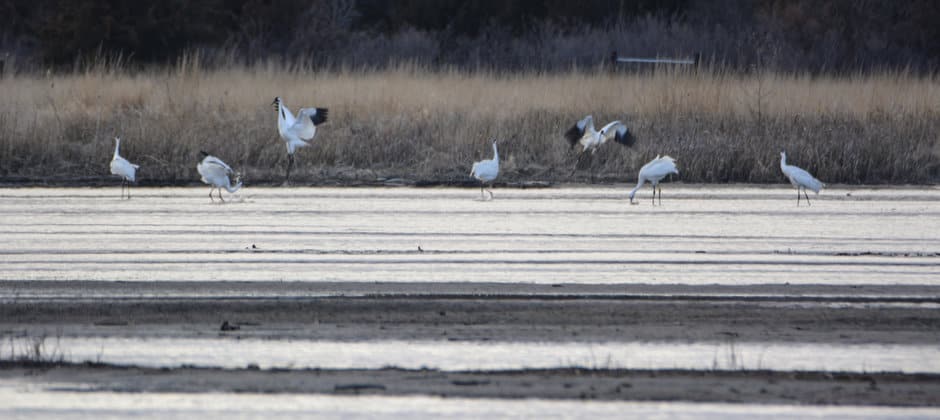Share this article
As whooping cranes rebound, flock sizes grow
As the endangered whooping crane has recovered from a mere 16 birds in the 1940s to over 500 today, their flock sizes have also increased during migration, researchers found.
Whooping cranes usually travel in family groups of three and under, or a couple of families together, but researchers have noticed much larger flocks migrating from their Texas wintering grounds to their breeding grounds in Alberta, Canada. In fact, a mega-group of 150 birds was recently documented in Saskatchewan.
“What’s interesting is this bird is generally a territorial bird on their wintering and breeding grounds,” said Andrew Caven, the director of conservation research at the nonprofit Crane Trust, and lead author of the study published in Heliyon. “We never thought of it as a gregarious bird.”
But in the last five to 10 years, Caven and his colleagues began noticing large groups of whooping cranes in Nebraska, that didn’t seem to be incidental sightings.
In the study, Caven and his colleagues used a public sighting database that has been running since the 1940s to determine if and where these flock sizes were increasing and if this was happening more frequently. Sighting data was also used from state, federal and private organizations on the species’ entire migratory path. The U.S. Fish and Wildlife Service and a number of partners help confirm that these sightings or photos of sightings are, in fact, whooping cranes.
The researchers found that large groups of seven or more whooping cranes were becoming increasingly common. “Large groups are increasing in frequency of occurrence, as a proportion to the total groups sighted, and at a rate that exceeds population growth,” Caven said.
While population growth was a factor in larger flocks, Caven said something else was at play, too. He and his colleagues investigated at a landscape level and found that larger flocks of whooping cranes roosted in the southern Great Plains, where high-quality wetlands were limited. Those wetlands likely disappeared due to sedimentation or were drained for farming. There were only a few concentrated areas of good wetlands where many of the whooping cranes were gathering. “In the Great Plains, only a small percent of the landscape is protected,” Caven said. “But a good portion of these groups of cranes are in protected wetlands.”
Conversely, they found that in the Dakotas, where wetland habitat is more sufficient, whooping cranes were also forming large groups, albeit at a lower rate, near the migration centerline where they would be most likely to encounter each other. The birds are likely using each other as a cue for habitat quality and are also practicing safety in numbers. “They can keep eating and foraging while other birds in the flock help them keep track of external threats,” he said.
As their populations grow, so do their flock sizes, Caven’s team found, but their behavior is changing, too, which may be a positive result of their recovery.
“There are novel challenges and also novel opportunities,” he said. “They’re not quite as territorial as we thought.”
Larger flocks of whooping cranes may also come with problems, Caven said. For example, more cranes concentrated together could put them at risk of spreading diseases like avian cholera or cause mass die-offs from hail or ice storms.
But conservation of wetlands where the birds are congregating together can help by providing more areas for the birds to spread out. “We’re getting to a point culturally where the Great Plains is running out of groundwater,” he said. “Wetland restoration contributes to groundwater stores and generation. We’re really at a place where were starting to think long term what’s good for us as humans is also good for whooping cranes.”
Header Image: Seven whooping cranes in the main channel of the Platte River near Wood River, Nebraska in April 2018. Increasing populations and lack of wetland habitat have resulted in larger flocks of migrating whooping cranes. ©Emma M. Brinley Buckley








